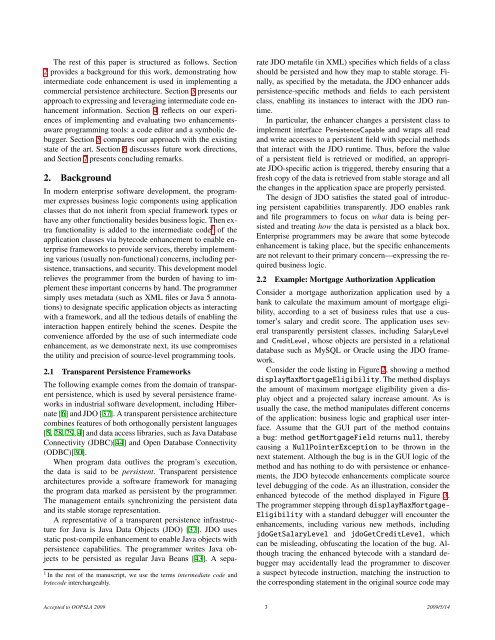Enhancing Source-Level Programming Tools with An Awareness of ...
Enhancing Source-Level Programming Tools with An Awareness of ...
Enhancing Source-Level Programming Tools with An Awareness of ...
Create successful ePaper yourself
Turn your PDF publications into a flip-book with our unique Google optimized e-Paper software.
The rest <strong>of</strong> this paper is structured as follows. Section2 provides a background for this work, demonstrating howintermediate code enhancement is used in implementing acommercial persistence architecture. Section 3 presents ourapproach to expressing and leveraging intermediate code enhancementinformation. Section 4 reflects on our experiences<strong>of</strong> implementing and evaluating two enhancementsawareprogramming tools: a code editor and a symbolic debugger.Section 5 compares our approach <strong>with</strong> the existingstate <strong>of</strong> the art. Section 6 discusses future work directions,and Section 7 presents concluding remarks.2. BackgroundIn modern enterprise s<strong>of</strong>tware development, the programmerexpresses business logic components using applicationclasses that do not inherit from special framework types orhave any other functionality besides business logic. Then extrafunctionality is added to the intermediate code 1 <strong>of</strong> theapplication classes via bytecode enhancement to enable enterpriseframeworks to provide services, thereby implementingvarious (usually non-functional) concerns, including persistence,transactions, and security. This development modelrelieves the programmer from the burden <strong>of</strong> having to implementthese important concerns by hand. The programmersimply uses metadata (such as XML files or Java 5 annotations)to designate specific application objects as interacting<strong>with</strong> a framework, and all the tedious details <strong>of</strong> enabling theinteraction happen entirely behind the scenes. Despite theconvenience afforded by the use <strong>of</strong> such intermediate codeenhancement, as we demonstrate next, its use compromisesthe utility and precision <strong>of</strong> source-level programming tools.2.1 Transparent Persistence FrameworksThe following example comes from the domain <strong>of</strong> transparentpersistence, which is used by several persistence frameworksin industrial s<strong>of</strong>tware development, including Hibernate[6] and JDO [37]. A transparent persistence architecturecombines features <strong>of</strong> both orthogonally persistent languages[5, 28, 29, 4] and data access libraries, such as Java DatabaseConnectivity (JDBC)[44] and Open Database Connectivity(ODBC)[30].When program data outlives the program’s execution,the data is said to be persistent. Transparent persistencearchitectures provide a s<strong>of</strong>tware framework for managingthe program data marked as persistent by the programmer.The management entails synchronizing the persistent dataand its stable storage representation.A representative <strong>of</strong> a transparent persistence infrastructurefor Java is Java Data Objects (JDO) [37]. JDO usesstatic post-compile enhancement to enable Java objects <strong>with</strong>persistence capabilities. The programmer writes Java objectsto be persisted as regular Java Beans [43]. A sepa-1 In the rest <strong>of</strong> the manuscript, we use the terms intermediate code andbytecode interchangeably.rate JDO metafile (in XML) specifies which fields <strong>of</strong> a classshould be persisted and how they map to stable storage. Finally,as specified by the metadata, the JDO enhancer addspersistence-specific methods and fields to each persistentclass, enabling its instances to interact <strong>with</strong> the JDO runtime.In particular, the enhancer changes a persistent class toimplement interface PersistenceCapable and wraps all readand write accesses to a persistent field <strong>with</strong> special methodsthat interact <strong>with</strong> the JDO runtime. Thus, before the value<strong>of</strong> a persistent field is retrieved or modified, an appropriateJDO-specific action is triggered, thereby ensuring that afresh copy <strong>of</strong> the data is retrieved from stable storage and allthe changes in the application space are properly persisted.The design <strong>of</strong> JDO satisfies the stated goal <strong>of</strong> introducingpersistent capabilities transparently. JDO enables rankand file programmers to focus on what data is being persistedand treating how the data is persisted as a black box.Enterprise programmers may be aware that some bytecodeenhancement is taking place, but the specific enhancementsare not relevant to their primary concern—expressing the requiredbusiness logic.2.2 Example: Mortgage Authorization ApplicationConsider a mortgage authorization application used by abank to calculate the maximum amount <strong>of</strong> mortgage eligibility,according to a set <strong>of</strong> business rules that use a customer’ssalary and credit score. The application uses severaltransparently persistent classes, including Salary<strong>Level</strong>and Credit<strong>Level</strong> , whose objects are persisted in a relationaldatabase such as MySQL or Oracle using the JDO framework.Consider the code listing in Figure 2, showing a methoddisplayMaxMortgageEligibility. The method displaysthe amount <strong>of</strong> maximum mortgage eligibility given a displayobject and a projected salary increase amount. As isusually the case, the method manipulates different concerns<strong>of</strong> the application: business logic and graphical user interface.Assume that the GUI part <strong>of</strong> the method containsa bug: method getMortgageField returns null, therebycausing a NullPointerException to be thrown in thenext statement. Although the bug is in the GUI logic <strong>of</strong> themethod and has nothing to do <strong>with</strong> persistence or enhancements,the JDO bytecode enhancements complicate sourcelevel debugging <strong>of</strong> the code. As an illustration, consider theenhanced bytecode <strong>of</strong> the method displayed in Figure 3.The programmer stepping through displayMaxMortgage-Eligibility <strong>with</strong> a standard debugger will encounter theenhancements, including various new methods, includingjdoGetSalary<strong>Level</strong> and jdoGetCredit<strong>Level</strong>, whichcan be misleading, obfuscating the location <strong>of</strong> the bug. Althoughtracing the enhanced bytecode <strong>with</strong> a standard debuggermay accidentally lead the programmer to discovera suspect bytecode instruction, matching the instruction tothe corresponding statement in the original source code mayAccepted to OOPSLA 2009 3 2009/5/14
















